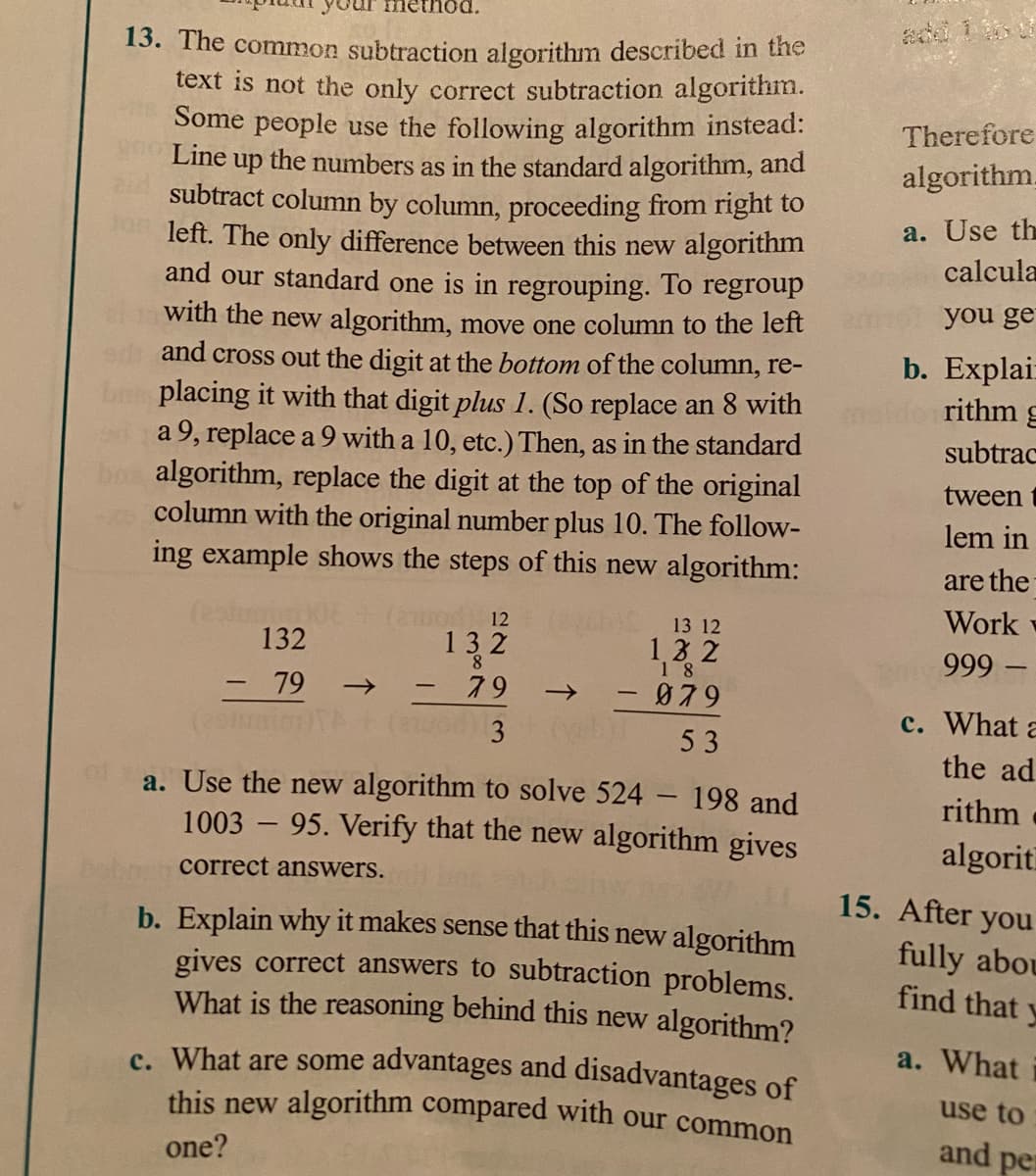13. The common subtraction algorithm described in the text is not the only correct subtraction algorithm. Some people use the following algorithm instead: Line up the numbers as in the standard algorithm, and subtract column by column, proceeding from right to left. The only difference between this new algorithm and our standard one is in regrouping. To regroup with the new algorithm, move one column to the left d and cross out the digit at the bottom of the column, re- placing it with that digit plus 1. (So replace an 8 with a 9, replace a 9 with a 10, etc.) Then, as in the standard algorithm, replace the digit at the top of the original column with the original number plus 10. The follow- ing example shows the steps of this new algorithm: 13 12 132 132 8. 1,3 2 1 8 79 -> - 79 -079 3 53 a. Use the new algorithm to solve 524 198 and 1003 – 95. Verify that the new algorithm gives correct answers. 15. b. Explain why it makes sense that this new algorithm gives correct answers to subtraction problems. What is the reasoning behind this new algorithm? c. What are some advantages and disadvantages of this new algorithm compared with our common
13. The common subtraction algorithm described in the text is not the only correct subtraction algorithm. Some people use the following algorithm instead: Line up the numbers as in the standard algorithm, and subtract column by column, proceeding from right to left. The only difference between this new algorithm and our standard one is in regrouping. To regroup with the new algorithm, move one column to the left d and cross out the digit at the bottom of the column, re- placing it with that digit plus 1. (So replace an 8 with a 9, replace a 9 with a 10, etc.) Then, as in the standard algorithm, replace the digit at the top of the original column with the original number plus 10. The follow- ing example shows the steps of this new algorithm: 13 12 132 132 8. 1,3 2 1 8 79 -> - 79 -079 3 53 a. Use the new algorithm to solve 524 198 and 1003 – 95. Verify that the new algorithm gives correct answers. 15. b. Explain why it makes sense that this new algorithm gives correct answers to subtraction problems. What is the reasoning behind this new algorithm? c. What are some advantages and disadvantages of this new algorithm compared with our common
Elements Of Modern Algebra
8th Edition
ISBN:9781285463230
Author:Gilbert, Linda, Jimmie
Publisher:Gilbert, Linda, Jimmie
Chapter2: The Integers
Section2.8: Introduction To Cryptography (optional)
Problem 15E: a. Excluding the identity cipher, how many different translation ciphers are there using an alphabet...
Related questions
Question

Transcribed Image Text:13. The common subtraction algorithm described in the
text is not the only correct subtraction algorithm.
Some people use the following algorithm instead:
Line
Therefore
the numbers as in the standard algorithm, and
algorithm.
up
subtract column by column, proceeding from right to
on left. The only difference between this new algorithm
and our standard one is in regrouping. To regroup
a. Use th
calcula
you ge
with the new algorithm, move one column to the left
and cross out the digit at the bottom of the column, re-
placing it with that digit plus 1. (So replace an 8 with
da 9, replace a 9 with a 10, etc.) Then, as in the standard
algorithm, replace the digit at the top of the original
column with the original number plus 10. The follow-
ing example shows the steps of this new algorithm:
b. Explai:
rithm g
subtrac
tween
lem in
are the
Work
o12
132
13 12
132
13 2
18
999
79
- 79
079
->
-
c. What a
3
53
the ad
a. Use the new algorithm to solve 524 198 and
1003 – 95. Verify that the new algorithm gives
rithm
algorit
correct answers.
15. After you
b. Explain why it makes sense that this new algorithm
gives correct answers to subtraction problems.
What is the reasoning behind this new algorithm?
fully abou
find that y
a. What
c. What are some advantages and disadvantages of
this new algorithm compared with our common
use to
and per
one?
Expert Solution
This question has been solved!
Explore an expertly crafted, step-by-step solution for a thorough understanding of key concepts.
This is a popular solution!
Trending now
This is a popular solution!
Step by step
Solved in 3 steps

Recommended textbooks for you

Elements Of Modern Algebra
Algebra
ISBN:
9781285463230
Author:
Gilbert, Linda, Jimmie
Publisher:
Cengage Learning,

Elements Of Modern Algebra
Algebra
ISBN:
9781285463230
Author:
Gilbert, Linda, Jimmie
Publisher:
Cengage Learning,